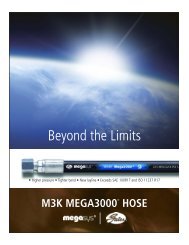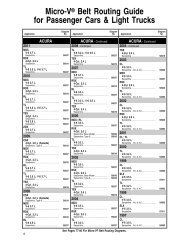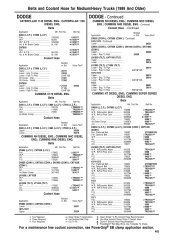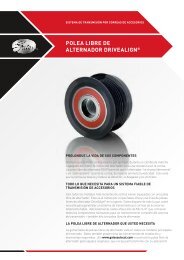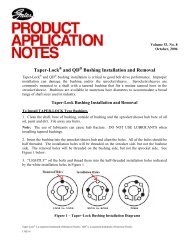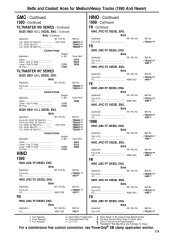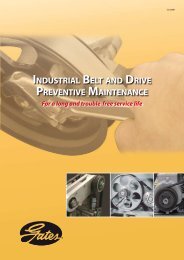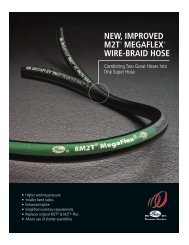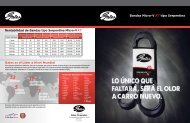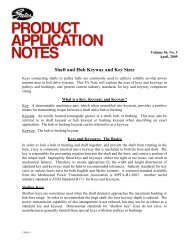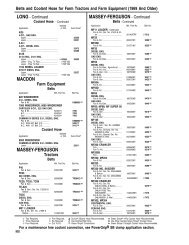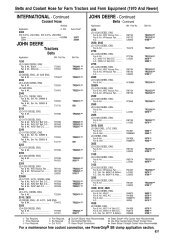PowerGrip® GT® Belt Drives
PowerGrip® GT® Belt Drives
PowerGrip® GT® Belt Drives
You also want an ePaper? Increase the reach of your titles
YUMPU automatically turns print PDFs into web optimized ePapers that Google loves.
Polyflex ® JB ® and Micro-V ® <strong>Belt</strong>s – Engineering<br />
III. Drive Alignment<br />
The “high performance” features (high HP capacity,<br />
smooth running, etc.) of Gates Polyflex JB and<br />
Micro-V belt drives may be realized on drives where<br />
proper sheave alignment is maintained. Polyflex JB<br />
and Micro-V belts should not be used on twisted or<br />
turned drives, or where shaft misalignment can<br />
exceed the amount specified in the following text.<br />
Sheave misalignment can cause belt instability, belt<br />
and sheave wear, strand separation, noise or<br />
excessive machine vibration.<br />
There are two types of misalignment:<br />
■ Parallel<br />
■ Angular<br />
Parallel misalignment occurs when the driveR and<br />
driveN shafts are parallel, but the sheave faces are<br />
in different planes. When the two shafts are not<br />
parallel the drive is angularly misaligned. Fig. 23<br />
illustrates both parallel and angular misalignment.<br />
The fleeting angle is the angle at which the belt<br />
enters and exists the sheave and is the sum of<br />
parallel and angular misalignment.<br />
Any degree of sheave misalignment will result in a<br />
reduction in belt life which is not accounted for in<br />
the normal drive design procedure. Misalignment<br />
of Polyflex JB and Micro-V belt drives should not<br />
exceed 1/4° or about 1/16 inch offset per foot of<br />
linear distance.<br />
One easy way to check alignment is to use a<br />
straightedge checking alignment in both directions.<br />
In other words, lay the straightedge across the face<br />
of the driveN sheave and check driveR alignment.<br />
Then lay the straightedge across the driveR and<br />
check the positioning of the driveN sheave. This<br />
procedure will check for both parallel and angular<br />
misalignment. (Make sure the groove location from<br />
the sheave face is equal for both sheaves. If they are<br />
not equal, allow for the difference when measuring<br />
alignment.)<br />
Figure 23 – Types of Misalignment<br />
IV. <strong>Belt</strong> Tensioning<br />
In order to obtain full benefit of all the performance<br />
advantages offered by using Polyflex JB and Micro-<br />
V drives on various applications, special attention is<br />
required for belt tensioning. Excessive belt slip can<br />
result from low belt tension or improper drive<br />
design. If a Polyflex JB belt slips, enough heat may<br />
be generated to cause catastrophic belt failure.<br />
Tensioning Polyflex JB and Micro-V drives by “feel”<br />
may result in performance problems unless the<br />
installer has extensive experience with the particular<br />
drive assembly. The relatively small belts, coupled<br />
with proportionally higher horsepower capacity<br />
makes the belts “feel” tighter than they actually are.<br />
For example, 50 pounds tension in a large industrial<br />
V-belt may not remove the sag, whereas 50 pounds<br />
in a 5M or J section belt makes them feel quite<br />
snug.<br />
It is common practice to measure installation<br />
tension. Numerical methods for measuring tension<br />
have several advantages. For example, they prevent<br />
over or under tensioning a drive, thus preventing<br />
possible bearing or belt damage.<br />
The procedures given below explain how to properly<br />
pre-tension a drive when it is stopped (static<br />
tension) so belt tension will be correct when the<br />
drive is operating. Static tension (sometimes<br />
referred to as installation tension) can be measured<br />
by the force-deflection method. The amount of force<br />
needed to deflect a belt a known amount (see Fig.<br />
24) is measured and compared to the recommended<br />
force. Adjustments can then be made as needed.<br />
Figure 24<br />
Step 1. Calculate the required static tension<br />
per strand.<br />
Formula 12 – English Units<br />
*T st (Static Tension) = 15 ( B G<br />
- G )<br />
Where: B = <strong>Belt</strong> type (5M Polyflex JB = 2.50, J<br />
Micro-V = 2.67)<br />
G = Arc correction factor from Table 33 on<br />
Page 72<br />
Nb = Number of <strong>Belt</strong>s (This is the total<br />
number of strands or ribs on the drive.)<br />
V = <strong>Belt</strong> speed (ft/min; Formula 11)<br />
m = Constant from Table 38.<br />
Tst = Static tension (lb), per strand.<br />
PD = Pitch Diameter (in) (See Table 32,<br />
Page 71.)<br />
Formula 13 – English Units<br />
V =<br />
(Design HP) (10 3 )<br />
(N b ) (V)<br />
Table 38 – Factor m, Y and Minimum<br />
*See note under Table Tst 31. (English)<br />
Cross Section m Y *Minimum T st (lb)<br />
5M Polyflex JB 0.050 1.20 8.0<br />
J Micro-V 0.035 0.56 2.8<br />
*See note under Table 31.<br />
(PD) (rpm)<br />
3.82<br />
, ft/min<br />
Formula 14 – Metric Units<br />
*T st (Static Tension) = 450 ( B G<br />
- G )<br />
(Design kW)<br />
(N b ) (V)<br />
+ mV2<br />
10 6 , lb.<br />
+ (mV 2 ) , N<br />
Where: B = <strong>Belt</strong> type (5M Polyflex JB = 2.50,<br />
J Micro-V = 2.67)<br />
G = Arc correction factor from Table 33 on<br />
Page 72<br />
Nb = Number of <strong>Belt</strong>s (This is the total<br />
number of strands or ribs on the drive.)<br />
V = <strong>Belt</strong> speed (m/s; Formula 8)<br />
m = Constant from Table 39, Page 79<br />
Tst = Static tension in Newtons, per strand<br />
PD = Pitch Diameter (mm) (See Table 32,<br />
Page 71.)<br />
78 The World’s Most Trusted Name in <strong>Belt</strong>s, Hose & Hydraulics.



